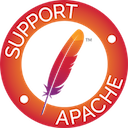Concepts
Concepts
ManifoldCF is a crawler framework which is designed to meet several key goals.
- It's reliable, and resilient against being shutdown or restarted
- It's incremental, meaning that jobs describe a set of documents by some criteria, and are meant to be run again and again to pick up any differences
- It supports connections to multiple kinds of repositories at the same time
- It defines and fully supports a model of document security, so that each document listed in a search result from the back-end search engine is one that the current user is allowed to see
- It operates with reasonable efficiency and throughput
- Its memory usage characteristics are bounded and predictable in advance
ManifoldCF meets many of its architectural goals by being implemented on top of a relational database. The current implementation requires Postgresql or uses the included Derby. Longer term, we may support other DB bindings.
ManifoldCF document model
Each document in ManifoldCF consists of some opaque binary data, plus some opaque associated metadata (which is described by name-value pairs), and is uniquely addressed by a URI. The back-end search engines which ManifoldCF communicates with are all expected to support, to a greater or lesser degree, this model.
Documents may also have access tokens associated with them. These access tokens are described more fully in the next section.
ManifoldCF security model
The ManifoldCF security model is based loosely on the standard authorization concepts and hierarchies found in Microsoft's Active Directory. Active Directory is quite common in the kinds of environments where data repositories exist that are ripe for indexing. Active Directory's authorization model is also easily used in a general way to represent authorization for a huge variety of third-party content repositories.
ManifoldCF defines a concept of an access token. An access token, to ManifoldCF, is a string which is meaningful only to a specific connector or connectors. This string describes the ability of a user to view (or not view) some set of documents. For documents protected by Active Directory itself, an access token would be an Active Directory SID (e.g. "S-1-23-4-1-45"). But, for example, for documents protected by Livelink a wholly different string would be used.
In the ManifoldCF security model, it is the job of an authority to provide a list of access tokens for a given searching user. Multiple authorities cooperate in that each one can add to the list of access tokens describing a given user's security. A user is described in terms of a set of authorization domains and user name tuples. Any given authority will provide access tokens for a user name corresponding to one authorization domain. For example, an authority that understands FaceBook users would only respond to a FaceBook user name. Access tokens from all applicable authorities are added into the final list that is handed to the search engine as part of every search request, so that the search engine may properly exclude documents that the user is not allowed to see.
When document indexing is done, therefore, it is the job of the crawler to hand access tokens to the search engine, so that it may categorize the documents properly according to their accessibility. The access tokens the crawler attaches to a document are meaningful only within the space of the governing authority group. An authority group describes a set of authorities which all can cooperate to provide access tokens for a single given document. Each authority belongs to exactly one authority group. Authority groups serve to separate access tokens into different spaces so that they cannot interfere with one another.
For example, say that you would want to crawl documents from a LiveLink repository, as well as from a Windows shared drive. You will therefore have two kinds of documents that are each secured in an entirely different way. There is a LiveLink authority connection, which provides LiveLink access tokens, and there is an Active Directory authority connection, which provides Windows access tokens. Now, you don't want there to be any chance that a LiveLink access token could be confused with an Active Directory SID, so the way you do that in ManifoldCF is to create two distinct authority groups, each of which provides access tokens meant for specific kinds of repository documents. Thus, documents secured by Active Directory SIDs should be indexed against an Active Directory authority group, and documents secured by LiveLink access tokens should have a LiveLink authority group. Finally, the Active Directory authority connection should then belong to the Active Directory authority group, and the LiveLink authority connection should belong to the LiveLink authority group.
In addition to specifying the correct authority group, access tokens can be attached to documents as "grant" tokens, or as "deny" tokens. "Grant" tokens provide access, "deny" tokens restrict it. "Deny" tokens, if matched, always win over "grant" tokens. And finally, there are multiple levels of tokens, which correspond to Active Directory's concepts of "share" security, specific "directory" security, or "file" security. (The latter concepts are rarely used except for documents that come from Windows or Samba systems.) Each level provided must agree that the document is to be visible for the document to appear in search results.
Once all these documents and their access tokens are handed to the search engine, it is the search engine's job to enforce security by excluding inappropriate documents from the search results. For Solr and for ElasticSearch, this infrastructure has been included in ManifoldCF releases as a Solr plugin (both 3.x and 4.x varieties) and an ElasticSearch plugin. Bear in mind that this plug-in is still not a complete solution, as it requires one or more authenticated user names to be passed to it from some upstream source, possibly a JAAS authenticator within an application server framework.
ManifoldCF conceptual entities
Connectors
ManifoldCF defines five different kinds of connectors. These are:
- User mapping connectors
- Authority connectors
- Repository connectors
- Transformation connectors
- Output connectors
All connectors share certain characteristics. First, they are pooled. This means that ManifoldCF keeps configured and connected instances of a connector around for a while, and has the ability to limit the total number of such instances to within some upper limit. Connector implementations have specific methods in them for managing their existence in the pools that ManifoldCF keeps them in. Second, they are configurable. The configuration description for a connector is an XML document, whose precise format is determined by the connector implementation. A configured connector instance is called a connection, by common ManifoldCF convention.
The function of each type of connector is described below.
| Connector type | Function |
|---|---|
| User mapping connector | Maps a user name to another (equivalent) user name, typically by means of a regular expression mechanism, or by repository access |
| Authority connector | Furnishes a standard way of mapping a user name to access tokens that are meaningful for a given type of repository |
| Repository connector | Fetches documents from a specific kind of repository, such as SharePoint or off the web |
| Transformation connector | Modifies documents or their metadata, after fetched by a repository connector and before being sent to the index by an output connector |
| Output connector | Pushes document ingestion requests and deletion requests to a specific kind of back end search engine or other entity, such as Lucene |
Connections
As described above, a connection is a connector implementation plus connector-specific configuration information. A user can define a connection of all three types in the crawler UI.
The kind of information included in the configuration data for a connector typically describes the "how", as opposed to the "what". For example, you'd configure a LiveLink connection by specifying how to talk to the LiveLink server. You would not include information about which documents to select in such a configuration.
There is one difference between how you define a repository connection or authority connection, vs. how you would define a transformation connection or output connection or mapping connection. The difference is that you must specify a governing authority group for your repository connection, and an owning authority group for your authority connection. This is because all documents ingested by ManifoldCF need to include appropriate access tokens, and those access tokens are specific to the governing authority group.
Another difference in how you define an authority connection or mapping connection, vs. other connections, is that you can specify a prerequisite mapping connection that must occur beforehand. This means you can have multiple user mappings that occur in a defined sequence, before the authority is invoked.
Jobs
A job in ManifoldCF parlance is a description of some kind of synchronization that needs to occur between a specified repository connection and a specified output connection. A job includes the following:
- A verbal description
- A repository connection (and thus implicitly an authority group as well)
- Zero or more transformation connections
- An output connection
- A repository-connection-specific description of "what" documents and metadata the job applies to
- Zero or more transformation-connection-specific descriptions of "how" documents and metadata should be manipulated before indexing
- An output-connection-specific description of how documents should be indexed
- A model for crawling: either "run to completion", or "run continuously"
- A schedule for when the job will run: either within specified time windows, or on demand
Jobs are allowed to share the same repository connection, and thus they can overlap in the set of documents they describe. ManifoldCF permits this situation, although when it occurs it is probably an accident.
Authorization domains
ManifoldCF supports a federated concept of a user. The same user, for instance, may have one login name for FaceBook, another for Windows, and yet another for Google. We can describe this user as having three different authorization domains: "FaceBook", "Windows", and "Google".
In ManifoldCF, each authority understands user names or ids from one specific authorization domain. This allows ManifoldCF to be configured so that access tokens generated from multiple independent sources are amalgamated, even if the incoming user names differ from source to source.
Authority groups
ManifoldCF groups authority connections together in groups, so that multiple authorities can furnish security for a single document. An authority group is nothing more than a name and a description that is referenced by authority connections that are part of that group, and is referenced also by repository connections that wish to be secured by that group. For most simple repositories, there is one authority group per authority. But repositories capable of federated security (e.g. SharePoint with Claim Space support) can use multiple authorities to describe security for a single document. Authority groups allow configuration of the appropriate many-to-many relationship for this situation.


